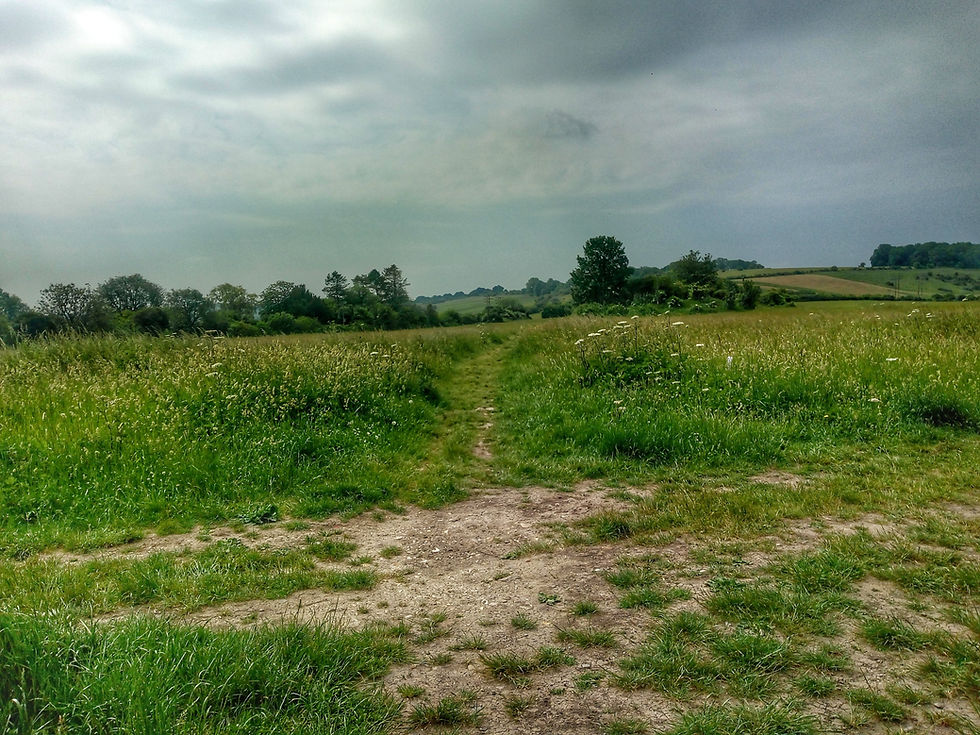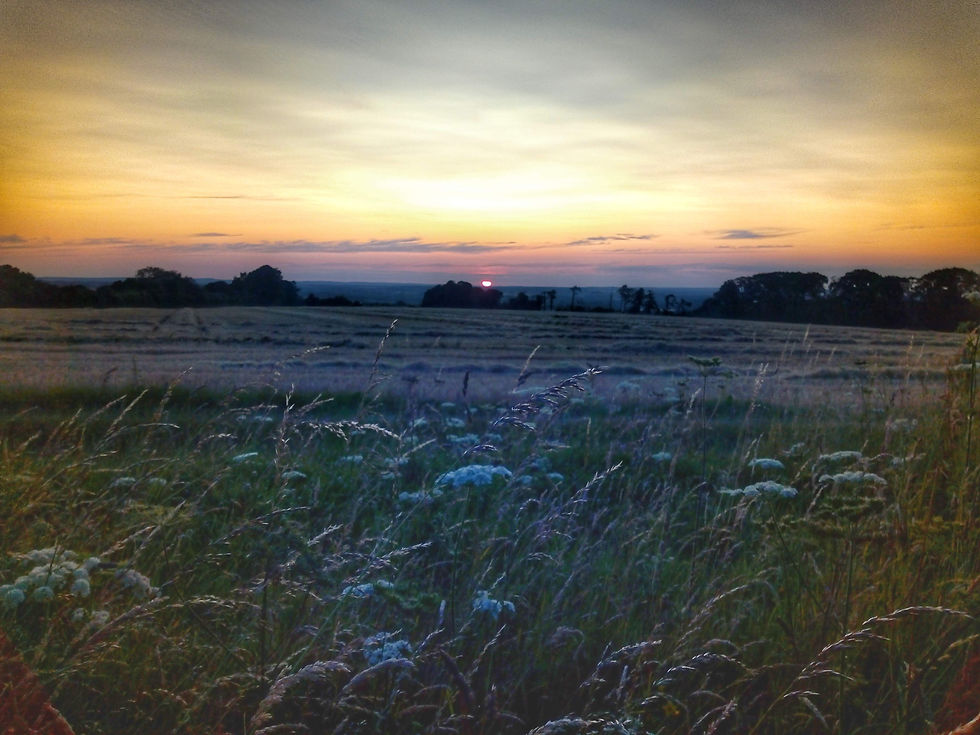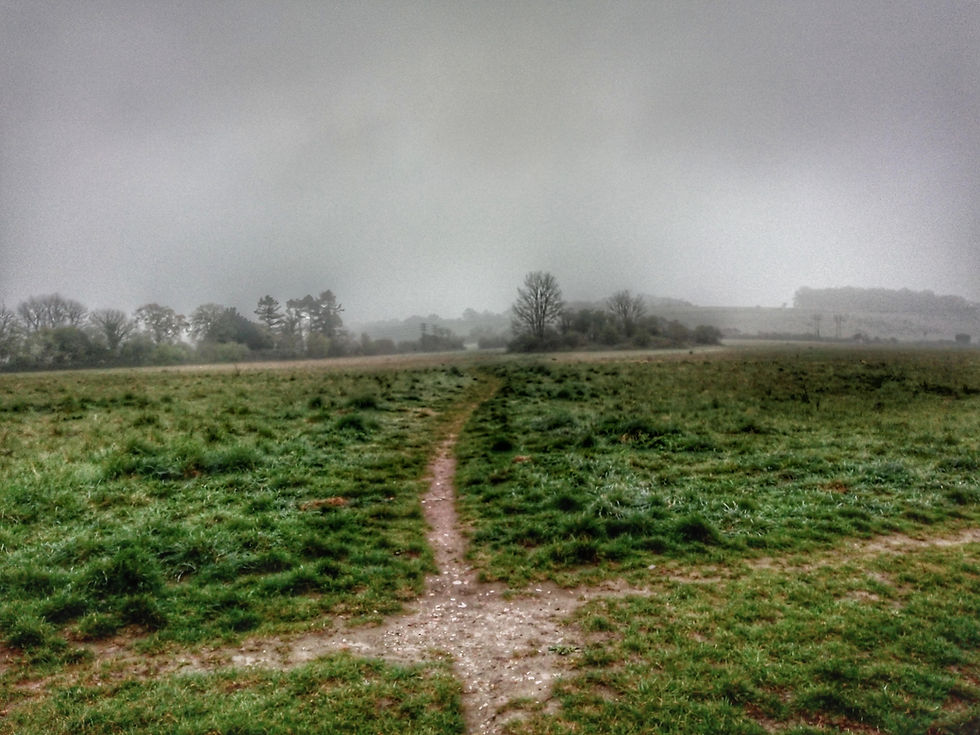The Folklore of Crossroads
- woodlarker

- May 28, 2022
- 7 min read

Years ago now, I was walking on the South Downs on a new-to-me footpath. It was pretty and I'd been strolling for a while, lost in thought. Patchy thorn bushes grew on either side of the path, and low plants in the grassy verges. There was the usual rutted chalk underfoot, ready to trip me up if I took my eyes off the path ahead and looked too long at the landscape around me. The skylarks sang overhead. As I rounded a slight bend, I felt a sense of foreboding. Not strong, fairly gentle really but just enough to prickle my senses and bring me out of my dreamy ambling. I searched in my mind but I couldn't quite place what it was telling me, what I was picking up on. It felt like something a little darker - but not bad, not immediately harmful, just very old, complex, and a feeling that belonged to this place, to this land.

With my senses sharpened, I continued on for maybe twenty or thirty feet towards a slightly wider area in the path ahead. It looked like the space opened up and there was a patch of grass growing in the centre of the trackway with an overhanging large tree giving shade. As I reached the grassy spot, I noticed a path coming from the other direction and intersecting it. It slowly dawned on me, and I couldn't help feeling surprised - I was picking up the foreboding because it was a crossroads!
I think almost everyone will know of the general folklore surrounding crossroads but, just in case you don't, they're said to be places for the burials of people who couldn't be given the usual Christian burial - suicides, criminals, you get the idea. It was a requirement that they were buried outside the city walls and it was thought that spirits were easily able to travel along straight roads. If they were placed at a crossroads instead, when their spirits rose at night they would be faced with the four pathways and feel utter confusion about which path to take. They would spend the whole night trying to work out which way to travel, by which time the sun would be rising and it would be too late ... until the following night when the scene would be repeated. It was said that any traveller passing through a crossroads at night would be inadvertently showing the spirits the correct path to take, bringing all sorts of trouble on themselves and others.
Now, I'd come across this folklore again and again, regurgitated in books and added in on web pages about such things. I wasn't sure I'd ever really believed it as such, more that I took it with a blind acceptance and not much thought. There are so many little snippets like that which we read or recite over and over but never actually question their validity. When I sensed the crossroads during my walk though, before I had any inkling that it was there, it felt like complete confirmation of the folklore. It inspired me to look a little deeper into it.

The further back in time we look, the more we find that the physical "seen" landscape overlapped with the spiritual, magickal landscape. They weren't separate as we see them through our scientific gaze today, but overlaid and intertwined. Spirits dwelled within stones, streams and trees (more on that in a future post), dragons slumbered inside hills and everything was permeated with magickal power and life force. We know this by looking at various Medieval and Anglo-Saxon sources, writings and place names, but there's no reason to think that the people before them thought of it any differently. My hunch would be that the further back in time we go, the more intertwined the worlds of the seen and unseen become.
Crossroads burials are occasionally documented from the middle Anglo-Saxon period onwards. They, sadly, seem to be the graves of some suicides, and historical charters also tell us that crossroads were occasionally the sites of executions. The information I found though seemed to indicate that, in documented or archaeological sites at least, the deciding factor seemed to be that they were at the point where several land boundaries met, rather than being specifically sited at crossroads.
More forthcoming was the information that crossroads were sometimes the site of gibbets where an executed criminal was hung in chains, sometimes for many years or even decades while the body slowly decomposed. This is especially true of sites situated on high ground where the gruesome sights of gibbets would be visible from all around. Any lowly traveller passing such a graphic scene would be left in no doubt that the town they were heading towards didn't take kindly to villains or wrongdoers. The sites also seem to be chosen if there were prehistoric "heathen" burial mounds placed there. Possibly, in a Christan age, they were seen as places which were already dark and demonic and, so, were fitting for the burials of outlaws and undesirables.
In 1687, a man called Loseby committed murder and was sentenced to be hanged atop an ancient roundbarrow next to the Roman road of Watling Street near Rugby in England. The siting follows the pattern of gibbets and gallows being placed close to, or on top of, prehistoric sites and burial mounds. It's possible though that the nearby crossroads was an even more important factor. The place became known as Loseby's Gibbet and, even after the barrow was later ploughed out, it's still known today at Gibbet Hill. The site of Caxton Gibbet was also at a major crossroads on the Roman road of Ermine Street.

There is a long tradition of stones being placed at crossroads - standing stones and stone crosses were frequently placed there, and many were given names. From a practical perspective, crossroads were often used as meeting places for convenience, and the stones and crosses placed on them could be used as boundary markers and also as destination landmarks and directional way pointers. Often, "cross" and "stone" seem to be used fairly interchangeably and sometimes the old documents suggest that an existing standing stone had probably been reworked into a cross. This is the case with the Coppelstone in Devon. The cross carving is of Scandinavian design and is has been suggested that the "copelan stan" (as it is recorded in a charter from 974) was reworked during the reign of the the Scandinavian king Cnut. He ruled England from 1016 - 1035 and was buried at Winchester. It's known from historical place names that he was connected with stones in that area - the village of Knowstone, just 17 miles from Copplestone, was recorded as Chenutdestana in 1086 and Cnutsstan in 1220.
It's also known that standing stones, whether at crossroads or not, were reworked into crosses as part of the Christian conversion of the people. Samson of Dol was a late fifth century saint. He found men dancing round a "simulacrum abominabile" on Bodmin Moor in Cornwall, which appears to have been a kind of standing stone. He carved a cross upon it, or possibly a nearby stone, and told the people that that should be revered instead.
As well as being recorded in charter documents, the use of stones at crossroads also leads us to historical written accounts of pagan practices at such places going further back into time. Martin of Braga, a sixth century archbishop from today's Portugal, wrote to a fellow bishop discussing the issue of rural paganism. He wrote of the burning of candles and other devotional activities at crossroads and of men throwing down heaps of stones at these places as offerings. The people obviously continued in their beliefs as five hundred years later, in the tenth century, another bishop called Burchard of Worms (in today's Germany) wrote his condemnation of herdsmen, hunters and wicked men in general who sang chants over herbs and ligatures (knots) at sacred places such as crossroads to heal their animals.
At the same time as Burchard of Worms lived, there was an abbot living much closer to here, in Wessex - Aelfric of Eynsham. He was born c.955 and was educated in Winchester under the bishop there. He believed the threat of witchcraft was very real and he wrote that witches "“still go to cross-roads and to heathen burials with their delusive magic and call to the devil; and he comes to them in the likeness of the man who is buried there, as if he arose from death.”. In his work De Auguriis, “About Omens”, he spoke of a heathen practice of drawing children through the ground at crossroads. This was also described by an archbishop called Wulfstan of York who died in 1023 but was equally as vague so, quite what this practice was remains unknown. Returning to stone crosses, it may well be that placement at these areas, which were considered to be dark and demonic, acted as a guard - consecrated and sacred.

So, we can see that crossroads do indeed have a genuinely dark reputation recorded in history. Whether that's deserved, or whether they were originally places to simply acknowledge the old gods, it's impossible to tell. Were they at one time (and if so, it was probably for a very long time) places where a weary traveller would add a small stone to a cairn, or place their hand on a standing stone? Perhaps they would say a few words as a blessing or a prayer, or leave an offering of sacred herbs. We know they were practical as meeting places and that they're often the places where boundaries join. Were they perhaps spaces where elders also came together with their neighbours, knowing that agreements and disagreements would be watched over and witnessed by the gods and guardians of the land. I wonder if the dark associations came with Christianity - after all, we know it didn't sit well with the old beliefs. Everything possible was done to steer the people away from their ancient practices and towards the church, so was the dark reputation purposely attached? If so, surely things have come a rather strange full circle with the placement of stone crosses at crossroads in order to bring the protection of the Christian god and to lighten a dark area with blessing and prayer.
Returning to the walk which began my wondering in the first place, I passed through the crossroads. As I emerged on the other side of it, I was stopped in my tracks by the sight of a hare. It's always astounding and intense to see a hare close up. They always seem impossibly huge! I froze my movements, at first trying to make sense of what I was seeing, and then afraid to move in case I broke this spell and this moment. It stayed still, sitting upright in the middle of the path ahead, looking straight at me and seemingly unafraid. I barely dared to breathe, taking in the details of its fur, its eye and the look of strength about its body. It felt magickal, a sign from the old gods maybe, or the ancestors, or even from the land itself. Somehow, it felt like confirmation once again that this was indeed a magickal place.

Do you know any crossroads folklore, or tales from your locality? Please share your thoughts in the comments section below.




In the United States, is the lore, of blues musician Robert Johnson, and (no relation) also Tommy Johnson, thst they independently went to a particular crossroads in Mississippi, in order to seek musical talent, fame and fortune, and did indeed make deals with "the devil". (On another note, many people know about the "27 Club" of celebrities who have passed at the very young age of 27 and I'm not sure if it's related to the crossroads or not but it made me think of Robert Johnson passing at the age of 27, along with his alleged "deal with the devil" at the crossroads.) Back to my initial comment, I believe it's certainly possible that the stories are true, and…
Crossroads close to where i live in Scotland is well known as headless cross. Think i will have to do a bit more research to find out more ;)
Something to add would be my Lady Hecate. She is the Goddess of the crossroads and many would leave offerings to her at crossroads.